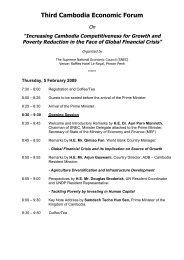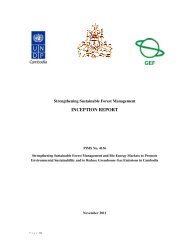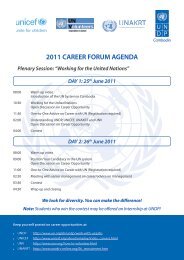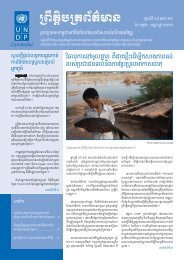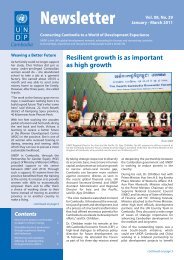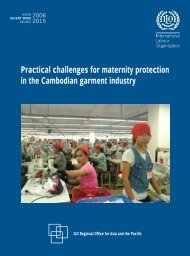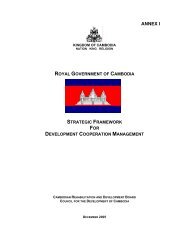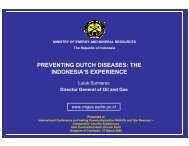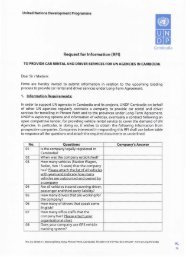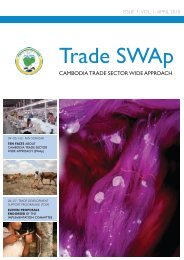UN Analysis Final.pdf - United Nations in Cambodia
UN Analysis Final.pdf - United Nations in Cambodia
UN Analysis Final.pdf - United Nations in Cambodia
Create successful ePaper yourself
Turn your PDF publications into a flip-book with our unique Google optimized e-Paper software.
III<br />
MAPPING<br />
DONOR-SUPPORTED<br />
AND GOVERNMENTAL<br />
YOUTH PROGRAMMES<br />
3.1 INTERNATIONAL COVENANTS AND CONVENTIONS ON YOUTH AND YO<strong>UN</strong>G CHILDREN<br />
The <strong>United</strong> <strong>Nations</strong> formally recognized the vital role of young people <strong>in</strong> the development of society<br />
through the Declaration on the Promotion among Youth of the Ideals of Peace, Mutual Respect and<br />
Understand<strong>in</strong>g between People <strong>in</strong> General Assembly resolution A/RES/2037 (XX) of 7 December 1965<br />
(<strong>United</strong> <strong>Nations</strong> 2007). Three decades later, the General Assembly, <strong>in</strong> resolution 50/81 of 14 December 1995,<br />
<strong>in</strong> paragraph 8(a) of the World Programme of Action for Youth, said: “every State shall provide its young<br />
people with opportunities for obta<strong>in</strong><strong>in</strong>g education, for acquir<strong>in</strong>g skills, and for participat<strong>in</strong>g fully <strong>in</strong> all aspects<br />
of society.”<br />
The Convention on the Rights of the Child (CRC), adopted unanimously by the <strong>UN</strong> General Assembly <strong>in</strong> 1989,<br />
is another covenant that supports young people. The Convention requires states to adopt all appropriate<br />
measures – legislative, adm<strong>in</strong>istrative, social, economic, budgetary, educational or other – and to allocate<br />
the resources necessary to ensure its effective implementation. The Convention recognises the obligations of<br />
other parties (i.e., parents and families, civil society and the <strong>in</strong>ternational community) for the provision of care,<br />
food and warmth, or for lov<strong>in</strong>g stimulus, basic education and health care (ILO 2002).<br />
In its commitment to standardize labour, and to also protect young workers, the <strong>Cambodia</strong>n Government<br />
ratified a number of fundamental ILO conventions: Forced Labour Convention (No. 29); Abolition of<br />
Forced Labour Convention (No. 105); Freedom of Association and Protection of the Right to Organise<br />
Convention (No. 87); Right to Organise and Collective Barga<strong>in</strong><strong>in</strong>g Convention (No. 98); Equal Remuneration<br />
Convention (No. 100); Discrim<strong>in</strong>ation Convention (No. 111); and M<strong>in</strong>imum Age Convention (No. 138). In November<br />
2007, the country ratified the Convention on the Worst Forms of Child Labour (Convention No. 182) (ILO 2007).<br />
<strong>Cambodia</strong> is also a signatory to the 1990 <strong>UN</strong> Convention on the Protection of the Rights of All Migrant<br />
Workers and Members of Their Families, although it has yet to ratify it (Lee, n.d.).<br />
Bilateral treaties and memorandums of agreement also underp<strong>in</strong> particular issues that affect youth. To<br />
promote safe migration for work, <strong>Cambodia</strong> has mutual labour cooperation agreements with Malaysia,<br />
the Republic of Korea and Thailand. Through a Memorandum of Understand<strong>in</strong>g (MoU) on Cooperation <strong>in</strong><br />
the Employment of Workers signed <strong>in</strong> May 2003, the Thai Government has accepted and legalized the status<br />
of <strong>Cambodia</strong>ns who are work<strong>in</strong>g <strong>in</strong> Thailand illegally (Lee, n.d.). Both countries also set up an Inter-M<strong>in</strong>istries<br />
Work<strong>in</strong>g Group for Cooperation to issue identification cards to Khmer migrant workers <strong>in</strong> Thailand, which<br />
allows them to apply for a work permit. <strong>Cambodia</strong>’s official mutual agreement with Malaysia, Recruitment<br />
Procedures for <strong>Cambodia</strong>n Nationals for Employment <strong>in</strong> Malaysia (1997/1999), has allowed the country,<br />
s<strong>in</strong>ce 1998, to officially send its workers to Malaysia, the majority of whom are women, who work as domestic<br />
workers, factory workers and shop assistants. Another related agreement is the Coord<strong>in</strong>ated Mekong<br />
M<strong>in</strong>isterial Initiative aga<strong>in</strong>st Traffick<strong>in</strong>g (COMMIT), an MoU, signed <strong>in</strong> 2004 by <strong>Cambodia</strong> and five countries<br />
Situation <strong>Analysis</strong> of Youth <strong>in</strong> <strong>Cambodia</strong><br />
23




